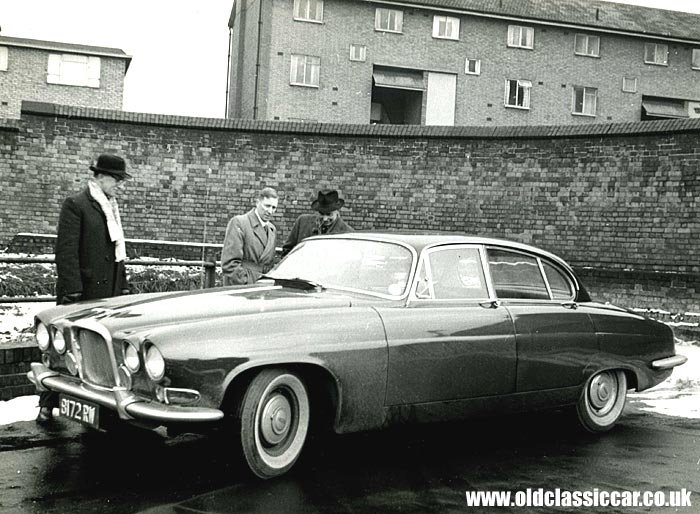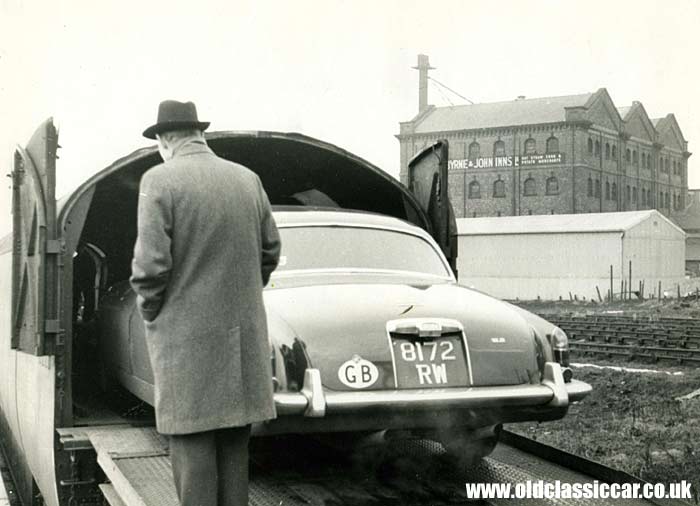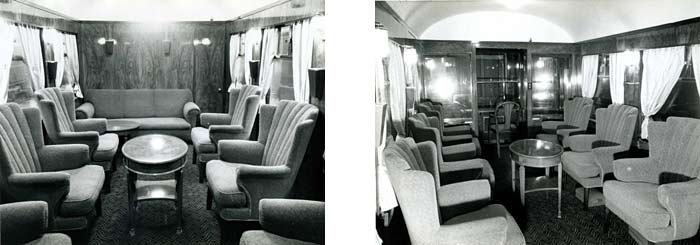Jaguar Mark 10.
The first two photos feature a Mk10 Jaguar being prepared and then loaded into an enclosed BR "car train". These specially-built carriages were designed for the widest of cars, as demonstrated by the Mk10, which at nearly 6ft 4ins wide was the widest car built in Britain. The car is registered 8172 RW, could it be a Jaguar press car perhaps? many of the firm's own cars wore RW (Coventry) registrations. The first picture shows three hatted gents admiring the mighty Mk X saloon, perhaps wondering if it will actually fit inside the carriage. Note the whitewall tyres.
|

|
|
Photo number 2 shows the Jag part-loaded, engine running, as it nosed it's way up the ramp and inside the carriage. The driver must have been a slim chap, as it'd be a squeeze opening the door to get out once the car was inside. Does anyone recognise the mill in the background? A sign on the exterior wall advertises "Byrne & John Inns Ltd - Hay Straw Corn & Potato Merchants". A smaller sign just visible on the original photo also reads "Turner Byrne & John Inns". These photos date to 1963 I believe.
|

|
|
In many ways this arrangement is similar to that now used on the Eurotunnel, albeit I suspect with more comfortable accomodation on offer. Below are two small photos that show the passenger compartment available to the cars' occupants during their rail journey - very comfortable!! These two photos are stamped "British Railways Drawing Office - Doncaster", so perhaps the photos of the Jaguar being loaded were taken in that area? Does anyone remember riding in these carriages, or know when the British Railways' car trains were introduced and later de-commissioned?
|

|
Background to the Mk10 Jaguars.
These mighty Jaguars broke cover in 1961, powered by the established 3.8 litre straight six XK engine, fed by triple SU carburettors - a similar installation to that found under the bonnet of contemporary E-Types. It was Jaguar's most prestigious product at the time, taking over from the Mk9 and aimed at company directors, both in the UK and in the important US marketplace. This was the first Jaguar to introduce the four-headlamp 'nose' that would become a Jaguar saloon trademark - the same basic styling cues would later feature on Jaguar 420s, Daimler Sovereigns, and the XJ of 1968. In 1964 the Mk10's engine size increased to 4.2 litres. A limousine version of the Mk10, with a central glass partition, was also sold but only in small numbers. |
|
In 1966 the design received a mild make-over, transforming the Mk10 into the 420G. Visually there was little to separate the two versions, although the 420G (for Grand) featured a chromium waist trim, a revised front grille, and small flashing indicator lamps on the front wings. Two-tone paint schemes were also listed as an option, if Sir or Madam so desired. The 420G sold in far fewer numbers than the Mk10, principally because competition after 1968 from within it's own ranks, in the shapely form of the XJ6, proved too strong for the older model. |
|
The 420G faded away in 1970, although the Daimler DS420 limousine that was based on Mk10 running gear and chassis, continued in production until 1992. Good examples of the Mark 10 and 420G are thin on the ground. It rusted just as badly as most other cars of that era, its complex body construction often suffering from codged-up repairs, as the cars struggled on in their middle years. Many deteriorated even faster than the smaller Jaguars, simply because their impressive girth meant that most domestic garages couldn't house such a monster. Consequently cars sat outside, at the mercy of the elements, their curvaceous coachwork no match for the British climate. Many of those that did survive beyond mid-life, ended their years on the banger tracks, reducing yet further the supply of good or restorable cars today. The Mk2 is probably the favourite 'classic' Jaguar saloon of all time, with values for good examples correspondingly high. Restoring a Mk10 could easily cost more than a Mk2, but their lower final value when compared to Morse's favourite, puts off all but the most intrepid restorer. Anyone restoring one of these fine Jaguars may find the Mark 10 page in the classifieds section of some use.
|

|
A 1962-on Mk10 Jaguar.
The next snapshot shows a Mk10 registered as 9152 SF, thus hailing from the Edinburgh area. This fine 3.8 litre Jaguar appears to have been pressed into caravan towing duties, if the tourers in the background, and the fitment of mirror extensions to the Jaguar's wings, are anything to go by.
|
| (Please click the thumbnail to view full-size image.) |
|
|
|
Return to Old Car Photos Page No. 8.
|









